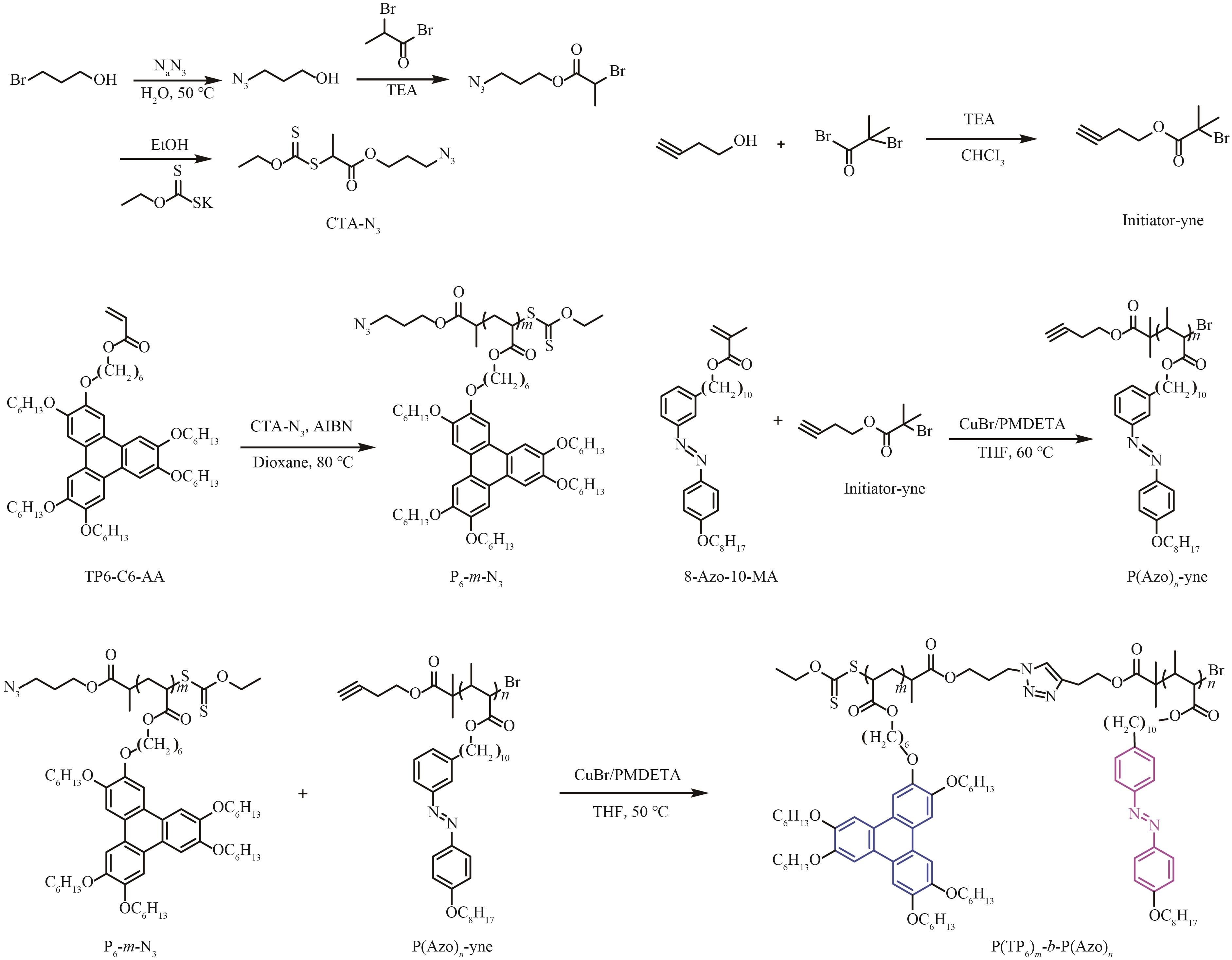
应用化学 ›› 2021, Vol. 38 ›› Issue (10): 1340-1352.DOI: 10.19894/j.issn.1000-0518.210343
含侧链盘状苯并菲和棒状偶氮苯的二嵌段液晶共聚物的可控合成及其光物理性质
张昭永1‡, 李谦1‡, 王大霖1, 方江邻2, 谌东中1( )
)
- 1南京大学化学化工学院高分子科学与工程系,高性能高分子材料与技术教育部重点实验室,南京 210023
2南京大学现代分析中心,南京 210093
-
收稿日期:2021-07-16接受日期:2021-08-31出版日期:2021-10-01发布日期:2021-10-15 -
通讯作者:谌东中 -
作者简介:‡共同第一作者 -
基金资助:国家自然科学基金项目(21875098)
Controlled Synthesis and Photophysical Properties of Liquid Crystalline Diblock Copolymers with Side⁃Chain Discotic Triphylene and Calamitic Azobenzene Mesogens
Zhao-Yong ZHANG1‡, Qian LI1‡, Da-Lin WANG1, Jiang-Lin FANG2, Dong-Zhong CHEN1( )
)
- 1Key Laboratory of High Performance Polymer Materials and Technology of Ministry of Education,Department of Polymer Science and Engineering,School of Chemistry and Chemical Engineering,Nanjing University,Nanjing 210023,China
2Center of Modern Analysis,Nanjing University,Nanjing 210093,China
-
Received:2021-07-16Accepted:2021-08-31Published:2021-10-01Online:2021-10-15 -
Contact:Dong-Zhong CHEN -
About author:cdz@nju.edu.cn
-
Supported by:National Natural Science Foundation of China(21875098)
摘要:
分别通过可逆加成-断裂链转移(RAFT)聚合和原子转移自由基聚合(ATRP)结合叠氮-端炔基大分子点击反应,制备了一系列不同聚合度和不同嵌段比例的基于侧链苯并菲TP盘状液晶基元和偶氮苯Azo棒状液晶基元的盘棒杂化二嵌段共聚物。采用核磁共振氢谱(1H NMR)、凝胶渗透色谱(GPC)、差示扫描量热分析(DSC)和正交偏光分析(POM)对盘棒杂化二嵌段共聚物的组成结构、相对分子质量和液晶相行为进行了表征。偶氮苯嵌段较短的共聚物P(TP6)40-b-P(Azo)10,主要表现出占优势嵌段TP盘状液晶聚合物的热转变温度与相行为。而偶氮苯嵌段较长的共聚物P(TP6)10-b-P(Azo)40和P(TP6)40-b-P(Azo)40则更多体现出类似Azo棒状侧链液晶聚合物的相行为和光响应特性。小角/广角X射线散射(SAXS/WAXS)分析证实了Azo嵌段较长的嵌段共聚物薄膜尤其经退火处理后呈现层状结构,倾向于平行基底取向排布的苯并菲诱导偶氮苯平躺沿着平行基底方向排列而显著减少了光吸收,经紫外及可见光的辐照后光吸收显著增大,其中盘状嵌段较长的P(TP6)40-b-P(Azo)40对比响应增幅尤其明显。这种盘棒杂化二嵌段共聚物薄膜所表现出的特殊光物理性质及其快速光响应-回复特性,加深了对其相互作用的理解,可望为设计合成新的光响应材料提供参考依据。
中图分类号:
引用本文
张昭永, 李谦, 王大霖, 方江邻, 谌东中. 含侧链盘状苯并菲和棒状偶氮苯的二嵌段液晶共聚物的可控合成及其光物理性质[J]. 应用化学, 2021, 38(10): 1340-1352.
Zhao-Yong ZHANG, Qian LI, Da-Lin WANG, Jiang-Lin FANG, Dong-Zhong CHEN. Controlled Synthesis and Photophysical Properties of Liquid Crystalline Diblock Copolymers with Side⁃Chain Discotic Triphylene and Calamitic Azobenzene Mesogens[J]. Chinese Journal of Applied Chemistry, 2021, 38(10): 1340-1352.
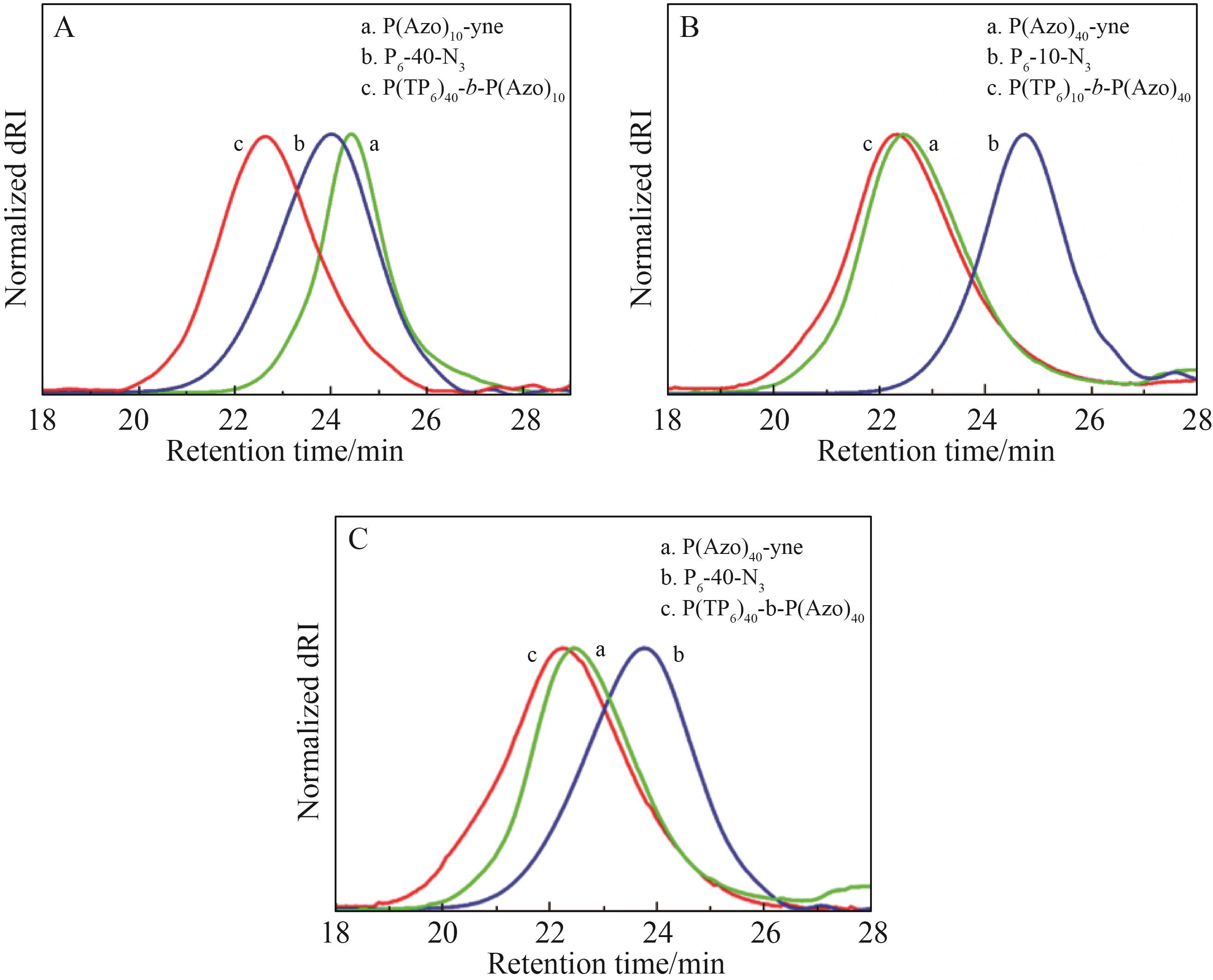
图1 嵌段共聚物(A)P(TP6)40-b-P(Azo)10、(B) P(TP6)10-b-P(Azo)40和(C)P(TP6)40-b-P(Azo)40及其对应起始均聚物的归一化GPC曲线
Fig.1 Normalized GPC curves of disk-rod hybrid diblock copolymers (A) P(TP6)40-b-P(Azo)10, (B) P(TP6)10-b-P(Azo)40 and (C) P(TP6)40-b-P(Azo)40
聚合物代号 Polymer code | 设计聚合度 Designed DP | 设计相对分子质量 Designed MW | 凝胶渗透色谱GPC | ||
|---|---|---|---|---|---|
质均相对分子质量 Mw,GPC | 数均相对分子质量 Mn,GPC | 多分散指数 PDI | |||
| P6?10?N3 | 10 | 9 300 | 9 500 | 7 200 | 1.31 |
| P6?40?N3 | 40 | 36 300 | 17 000 | 12 500 | 1.36 |
| P(Azo)10?yne | 10 | 5 400 | 8 300 | 7 000 | 1.19 |
| P(Azo)40?yne | 40 | 21 300 | 35 000 | 24 400 | 1.43 |
| P(TP6)40?b?P(Azo)10 | / | 41 700 | 36 300 | 24 800 | 1.46 |
| P(TP6)10?b?P(Azo)40 | / | 30 600 | 38 900 | 26 000 | 1.49 |
| P(TP6)40?b?P(Azo)40 | / | 57 600 | 41 300 | 27 500 | 1.50 |
表1 不同设计聚合度的嵌段共聚物及对应起始均聚物的分子表征结果
Table 1 Molecular characterization results of disk?rod hybrid diblock copolymers with different DP and their corresponding homopolymers via GPC
聚合物代号 Polymer code | 设计聚合度 Designed DP | 设计相对分子质量 Designed MW | 凝胶渗透色谱GPC | ||
|---|---|---|---|---|---|
质均相对分子质量 Mw,GPC | 数均相对分子质量 Mn,GPC | 多分散指数 PDI | |||
| P6?10?N3 | 10 | 9 300 | 9 500 | 7 200 | 1.31 |
| P6?40?N3 | 40 | 36 300 | 17 000 | 12 500 | 1.36 |
| P(Azo)10?yne | 10 | 5 400 | 8 300 | 7 000 | 1.19 |
| P(Azo)40?yne | 40 | 21 300 | 35 000 | 24 400 | 1.43 |
| P(TP6)40?b?P(Azo)10 | / | 41 700 | 36 300 | 24 800 | 1.46 |
| P(TP6)10?b?P(Azo)40 | / | 30 600 | 38 900 | 26 000 | 1.49 |
| P(TP6)40?b?P(Azo)40 | / | 57 600 | 41 300 | 27 500 | 1.50 |
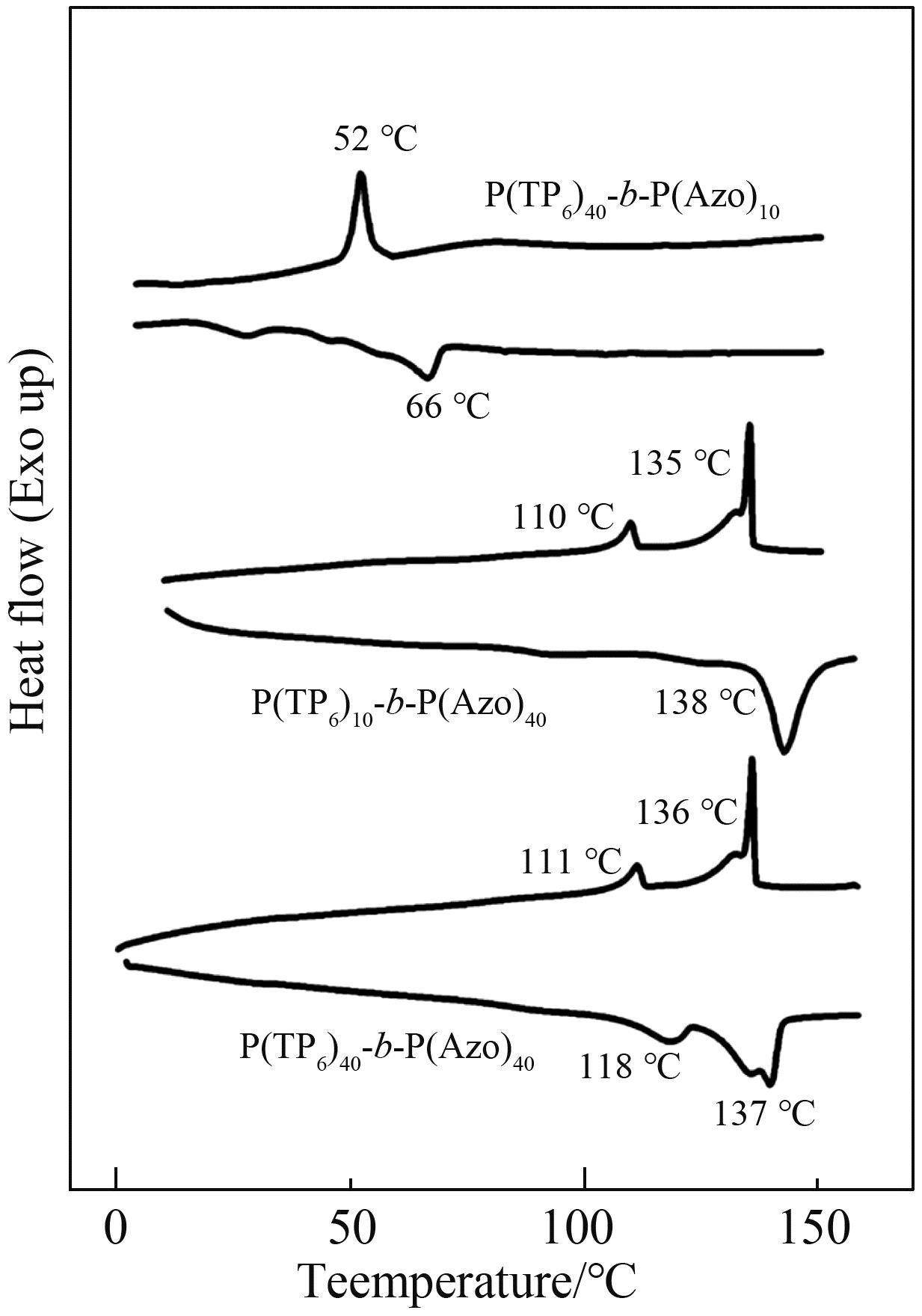
图2 不同嵌段比例的盘棒杂化嵌段共聚物的第1次降温与第2次升温DSC曲线
Fig.2 DSC curves of disk-rod hybrid diblock copolymers with variant block lengths during the first cooling and second heating scans at a rate of 10 ℃/min under a nitrogen atmosphere
聚合物代号 Polymer code | 相转变温度/℃(焓变/(J·g-1)) Phase transitions/℃(Enthalpy changes/(J·g-1)) | |
|---|---|---|
第1次降温 First cooling | 第2次升温 Second heating | |
| P(TP6)40?b?P(Azo)10 | I 52(7.5) Col | Col 26, 47, 58, 66(-7.1) I |
| P(TP6)10?b?P(Azo)40 | I 135(3.5) N 130(4.0) SmC 110(1.8) | SmC 138(-6.6) I |
| P(TP6)40?b?P(Azo)40 | I 136(3.5) N 131(4.0) SmC 111(1.8) | SmC 118(-2.0) N 132(-3.2) 137(-3.5) I |
表2 不同比例盘棒杂化嵌段共聚物的热转变性质及相态归属
Table 2 Thermal data and phase assignments of the series diblock copolymers of P(TP6)m?b?P(Azo)n
聚合物代号 Polymer code | 相转变温度/℃(焓变/(J·g-1)) Phase transitions/℃(Enthalpy changes/(J·g-1)) | |
|---|---|---|
第1次降温 First cooling | 第2次升温 Second heating | |
| P(TP6)40?b?P(Azo)10 | I 52(7.5) Col | Col 26, 47, 58, 66(-7.1) I |
| P(TP6)10?b?P(Azo)40 | I 135(3.5) N 130(4.0) SmC 110(1.8) | SmC 138(-6.6) I |
| P(TP6)40?b?P(Azo)40 | I 136(3.5) N 131(4.0) SmC 111(1.8) | SmC 118(-2.0) N 132(-3.2) 137(-3.5) I |

图3 P(TP6)40-b-P(Azo)10从室温升至各向同性态再冷却至室温的正交POM图像
Fig.3 POM images of the diblock copolymer P(TP6)40-b-P(Azo)10 under crossed polarizers (A) at room temperature, (B) heating up to isotropic phase and (C) slowly cooling down to room temperature

图4 P(TP6)10-b-P(Azo)40 (A—F)和P(TP6)40-b-P(Azo)40 (G—L)从室温升至各向同性态的正交POM照片
Fig.4 POM images of the diblock copolymers P(TP6)10-b-P(Azo)40 (A—F) and P(TP6)40-b-P(Azo)40 (G—L) under crossed polarizers upon heating from room temperature to the isotropic phase
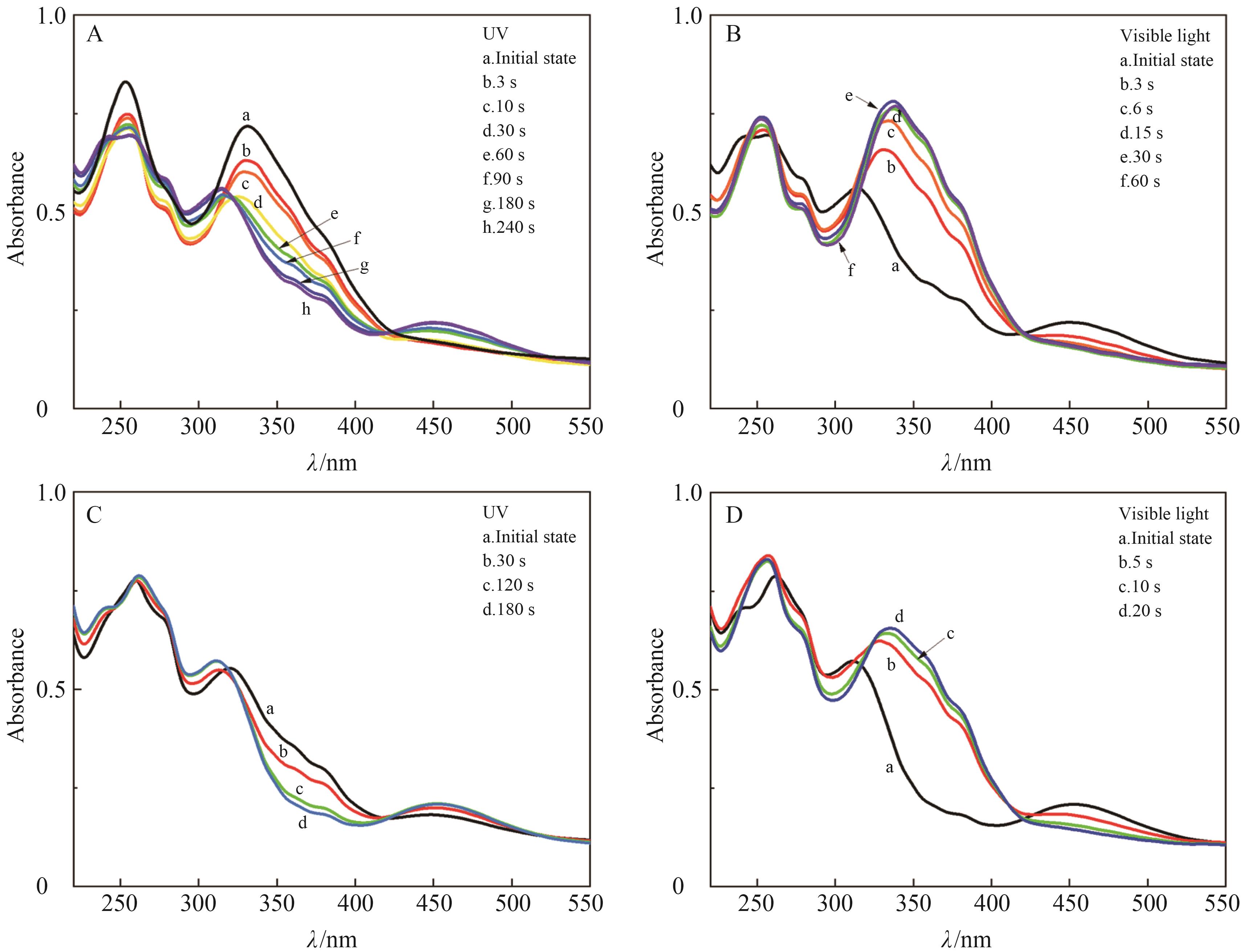
图5 偶氮苯Azo嵌段较长的两种嵌段共聚物P(TP6)10-b-P(Azo)40和P(TP6)40-b-P(Azo)40的薄膜在365 nm紫外光或可见光照射下的UV-Vis光谱变化,(A)P(TP6)10-b-P(Azo)40薄膜在365 nm紫外光照下的顺反异构化转变响应,与(B)可见光照下的回复过程;(C)P(TP6)40-b-P(Azo)40薄膜在紫外光照下的响应,与(D)可见光照下的回复过程
Fig.5 UV-Vis absorption spectra of the diblock copolymer films of (A) P(TP6)10-b-P(Azo)40 under irradiation of 365 nm UV light, and (B) recovery under illumination of the visible light; (C) P(TP6)40-b-P(Azo)40 under irradiation of 365 nm UV light, and (D) recovery under illumination of the visible light
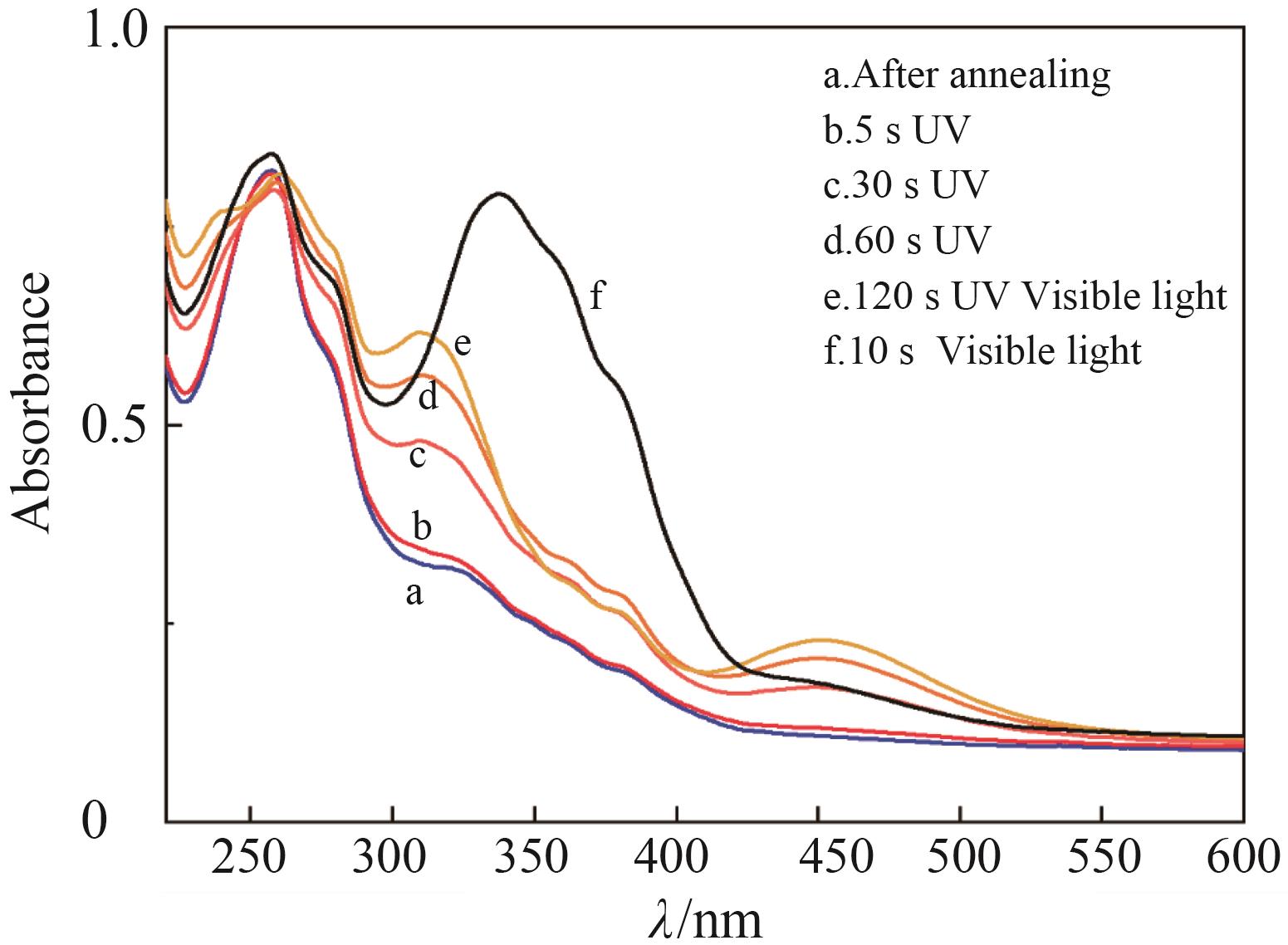
图6 退火后的P(TP6)40-b-P(Azo)40薄膜(a)经不同时间的365 nm紫外光辐照至顺式光稳态(b—e),然后再经可见光照射至反式稳态(f)的UV-Vis吸收光谱变化图
Fig.6 UV-Vis absorption spectra of the diblock copolymer film of P(TP6)40-b-P(Azo)40 after annealing (a), irradiated with 365 nm UV light for different time to cis photostationary state (b—e), and then illuminated with visible light transforming back to trans state (f)
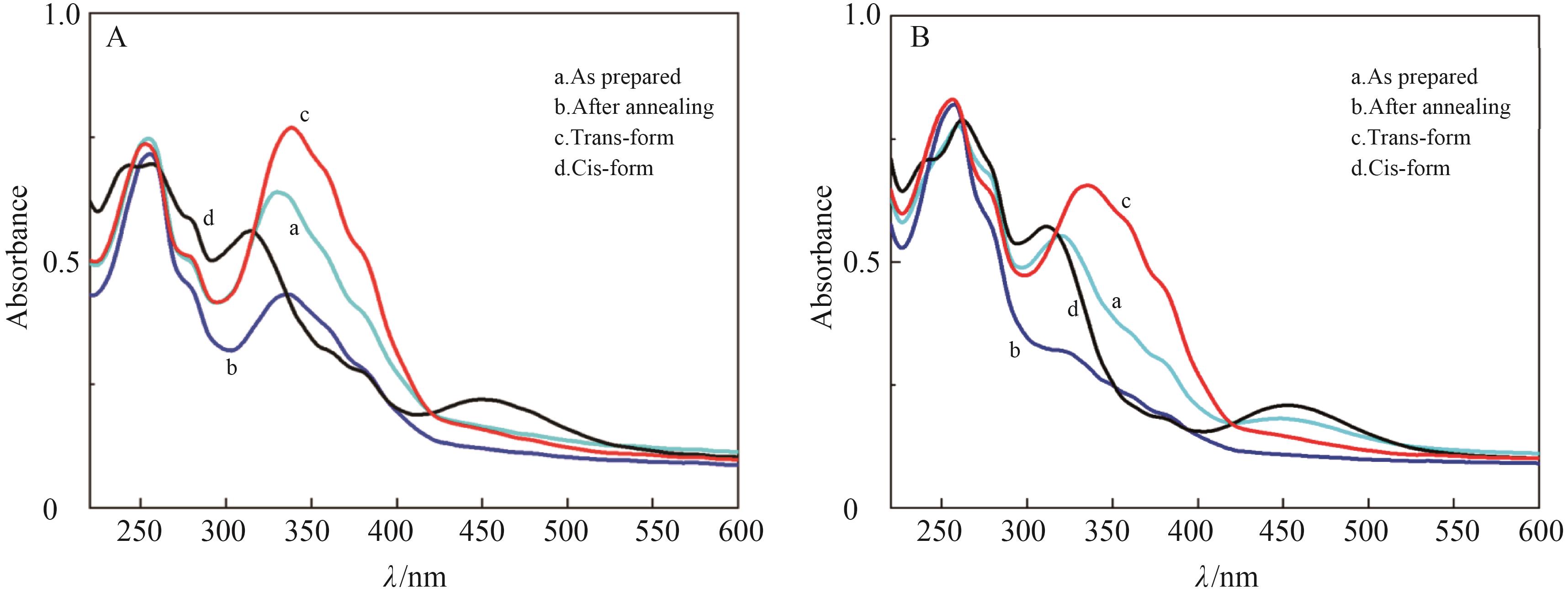
图7 (A) P(TP6)10-b-P(Azo)40和(B) P(TP6)40-b-P(Azo)40的聚合物薄膜由直接旋涂制膜(a)、经退火后(b)、反式稳态(c)和顺式光稳态(d)的UV-Vis谱图对比
Fig.7 UV-Vis absorption spectra comparison of the diblock copolymer films of (A) P(TP6)10-b-P(Azo)40 and (B) P(TP6)40-b-P(Azo)40 at different states, as-prepared spin coating film (a), after annealing (b), trans steady state (c) and cis photostationary state (d)
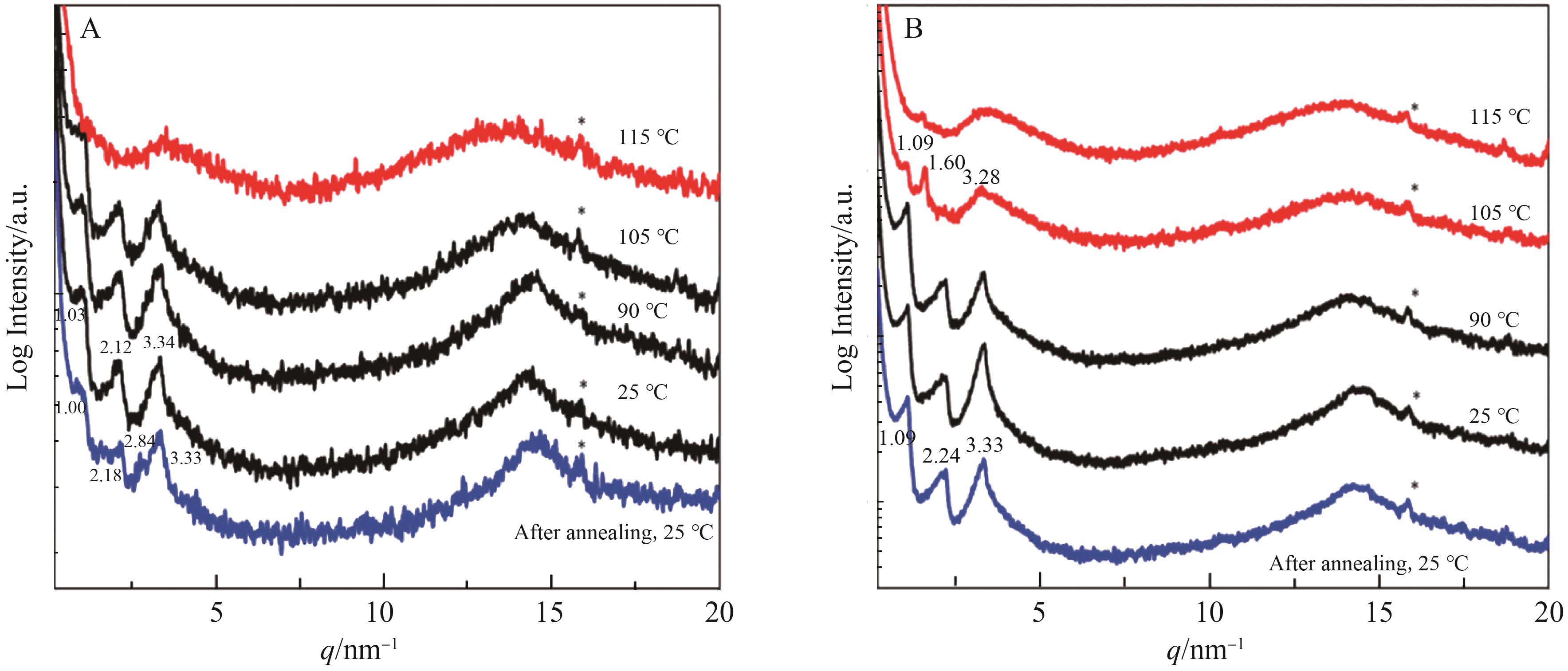
图8 P(TP6)10-b-P(Azo)40 和P(TP6)40-b-P(Azo)40的变温SAXS/WAXS曲线
Fig.8 Variable temperature SAXS/WAXS curves of (A) P(TP6)10-b-P(Azo)40 and (B) P(TP6)40-b-P(Azo)40, the peaks marked with a star * standing for the background signal from the aluminum foil base
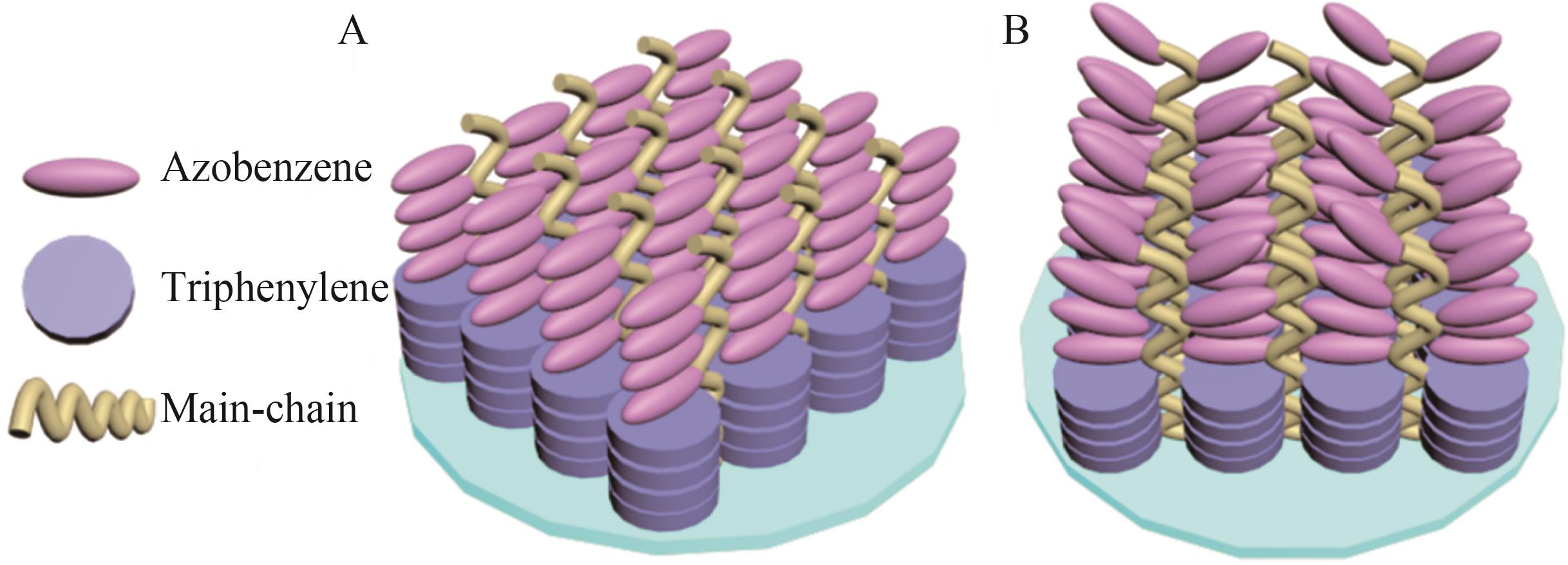
图9 (A)偶氮苯Azo嵌段较长的盘棒二嵌段共聚物P(TP6)40-b-P(Azo)40和P(TP6)10-b-P(Azo)40形成的大致分层结构,以及倾向于平行基底取向的盘状液晶基元苯并菲TP诱导棒状液晶基元偶氮苯Azo的水平排布,(B)365 nm紫外光以及可见光辐照后偶氮苯Azo的取向变化示意图
Fig.9 (A) Schematic illustration of the discotic triphenylene induced planar orientation of calamitic azobenzene mesogens in disc-rod diblock copolymer films of P(TP6)40-b-P(Azo)40 and P(TP6)10-b-P(Azo)40 with a longer azobenzene block, and (B) the orientational change after irradiation with 365 nm ultraviolet then visible light
| 1 | FLETCHER I D, LUCKHURST G R. The synthesis and characterization of novel nonsymmetrical dimers with rod-like and disk-like mesogenic units[J]. Liq Cryst, 1995, 18(2): 175-183. |
| 2 | TSCHIERSKE C, PHOTINOS D J. Biaxial nematic phases[J]. J Mater Chem, 2010, 20(21): 4263-4294. |
| 3 | MADSEN L A, DINGEMANS T J, NAKATA M, et al. Thermotropic biaxial nematic liquid crystals[J]. Phys Rev Lett, 2004, 92(14): 145505. |
| 4 | ACHARYA B R, PRIMAK A, KUMAR S. Biaxial nematic phase in bent-core thermotropic mesogens[J]. Phys Rev Lett, 2004, 92(14): 145506. |
| 5 | PRASAD V, KANG S W, SURESH K A, et al. Thermotropic uniaxial and biaxial nematic and smectic phases in bent-core mesogens[J]. J Am Chem Soc, 2005, 127(49): 17224-17227. |
| 6 | KEITH C, LEHMANN A, BAUMEISTER U, et al. Nematic phases of bent-core mesogens[J]. Soft Matter, 2010, 6(8): 1704-1721. |
| 7 | MAEDA H, TERASHIMA Y, HAKETA Y, et al. Discotic columnar mesophases derived from ‘rod-like’ pi-conjugated anion-responsive acyclic oligopyrroles[J]. Chem Commun, 2010, 46(25): 4559-4561. |
| 8 | MATRASZEK J, GRZESKIEWICZ K, GORECKA E, et al. Fluorescent bent-core mesogens with thiophene-based central unit[J]. Liq Cryst, 2020, 47(12): 1803-1810. |
| 9 | CIGL M, HAMPLOVA V, POCIECHA D, et al. Photosensitive bent-core compounds with azo-group attached to the central ring[J]. Crystals, 2020, 10(11): 14. |
| 10 | SKOPALOVA H, KOZMIK V, SMAHEL M, et al. Mesomorphic properties of non-symmetric bent-core liquid crystals with a lateral substituent in the apex position[J]. Liq Cryst, 2021, 48(7): 1010-1024. |
| 11 | APREUTESEI D, MEHL G H. Completely miscible disc and rod shaped molecules in the nematic phase[J]. Chem Commun, 2006(6): 609-611. |
| 12 | DATE R W, BRUCE D W. Shape amphiphiles: mixing rods and disks in liquid crystals[J]. J Am Chem Soc, 2003, 125(30): 9012-9013. |
| 13 | HUNT J J, DATE R W, TIMIMI T A, et al. Toward the biaxial nematic phase of low molar mass thermotropic mesogens: substantial molecular biaxiality in covalently linked rod-disk dimers[J]. J Am Chem Soc, 2001, 123(41): 10115-10116. |
| 14 | IMRIE C T, LU Z B, PICKENS J, et al. Oligomeric rod-disc nematic liquid crystals[J]. Chem Commun, 2007(12): 1245-1247. |
| 15 | JEONG K U, JING A J, MANSDORF B, et al. Biaxial molecular arrangement of rod-disc molecule under an electric field[J]. Chem Mater, 2007, 19(12): 2921-2923. |
| 16 | JEONG K U, JING A J, MANSDORF B, et al. Self-assembly of chemically linked rod-disc mesogenic liquid crystals[J]. J Phys Chem B, 2007, 111(4): 767-777. |
| 17 | KOUWER P H J, MEHL G H. Multiple levels of order in linked disc-rod liquid crystals[J]. Angew Chem Int Ed, 2003, 42(48): 6015-6018. |
| 18 | KOUWER P H J, MEHL G H. Full miscibility of disk- and rod-shaped mesogens in the nematic phase[J]. J Am Chem Soc, 2003, 125(37): 11172-11173. |
| 19 | KOUWER P H J, MEHL G H. Hierarchical organisation in shape-amphiphilic liquid crystals[J]. J Mater Chem, 2009, 19(11): 1564-1575. |
| 20 | KOUWER P H J, POURZAND J, MEHL G H. Disc-shaped triphenylenes in a smectic organisation[J]. Chem Commun, 2004(1): 66-67. |
| 21 | KOUWER P H J, WELCH C J, MCROBBIE G, et al. Mixtures of disc-shaped and rod-shaped mesogens with chiral components[J]. J Mater Chem, 2004, 14(12): 1798-1803. |
| 22 | MAHLSTEDT S, JANIETZ D, SCHMIDT C, et al. Novel donor-acceptor triple mesogens incorporating disc-like and rod-like molecular sub-units[J]. Liq Cryst, 1999, 26(9): 1359-1369. |
| 23 | PAL S K, KUMAR S, SETH J. Synthesis and characterisation of novel rod-disc oligomers[J]. Liq Cryst, 2008, 35(5): 521-525. |
| 24 | RAHMAN M L, TSCHIERSKE C, YUSOFF M, et al. Synthesis and liquid crystalline properties of a disc-shaped molecule with azobenzene at the periphery[J]. Tetrahedron Lett, 2005, 46(13): 2303-2306. |
| 25 | SHIMIZU Y, KUROBE A, MONOBE H, et al. Calamitic and discotic mesophases formed by kinetically controlled rod-disc alternation of molecular shape in a triphenylene-azobenzene mesogenic system[J]. Chem Commun, 2003(14): 1676-1677. |
| 26 | TANAKA D, ISHIGURO H, SHIMIZU Y, et al. Thermal and photoinduced liquid crystalline phase transitions with a rod-disc alternative change in the molecular shape[J]. J Mater Chem, 2012, 22(48): 25065-25071. |
| 27 | DEVI S, BALA I, GUPTA S P, et al. Reversibly photoswitchable alkoxy azobenzenes connected benzenetricarboxamide discotic liquid crystals with perpetual long range columnar assembly[J]. Org Biomol Chem, 2019, 17(7): 1947-1954. |
| 28 | SPERNER M, TOBER N, DETERT H. Tristriazolotriazines with azobenzene arms-acidochromic dyes and discotic liquid crystals[J]. Eur J Org Chem, 2019(29): 4688-4693. |
| 29 | LIU Y R, LI W, ZHOU X, et al. Highly ordered smectic structures of disc-rod luminescent liquid crystals: the role of the tolane group[J]. J Mater Chem C, 2021, 9(10): 3555-3561. |
| 30 | EBERT M, WENDORFF J H. Polyesters containing both rod-like and disc-like mesogens[J]. Makromol Chem, 1992, 193(2): 507-513. |
| 31 | PAN S, MU B, ZHOU Y, et al. Competition and compromise between discotic and calamitic mesogens in triphenylene and azobenzene based shape-amphiphilic liquid crystals[J]. RSC Adv, 2016, 6(55): 49556-49566. |
| 32 | WU B, MU B, CHEN D Z, et al. Triphenylene-based side chain liquid crystalline block copolymers containing a PEG block: controlled synthesis, microphase structures evolution and their interplay with discotic mesogenic orders[J]. Macromolecules, 2013, 46(8): 2916-2929. |
| 33 | MU B, WU B, CHEN D Z, et al. Hierarchical self-organization and uniaxial alignment of well synthesized side-chain discotic liquid crystalline polymers[J]. Macromolecules, 2015, 48(8): 2388-2398. |
| 34 | LI X, MU B, CHEN D Z, et al. Significantly enhanced thermotropic liquid crystalline columnar mesophases in stereoregular polymethylenes with discotic triphenylene side groups[J]. Macromolecules, 2019, 52(18): 6913-6926. |
| 35 | MU B, PAN S, CHEN D Z, et al. Well-organized columnar superlattices via positive coupling between polymer backbone and discotic side groups[J]. Macromolecules, 2015, 48(19): 6768-6780. |
| 36 | SHI Z H, LU H J, CHEN D Z, et al. Rational design, syntheses, characterization and solution behavior of amphiphilic azobenzene-containing linear-dendritic block copolymers[J]. Polymer 2012, 53(2): 359-369. |
| 37 | DUAN J F, MA J, CHEN D Z, et al. Formation of persistent ordered lamellar mesophases in azobenzene-containing silver thiolates and their implications for controlled synthesis of silver nanomaterials[J]. J Mater Chem C, 2014, 2(13): 2375-2386. |
| 38 | PAN S, NI M F, CHEN D Z, et al. Well-defined pillararene-based azobenzene liquid crystalline photoresponsive materials and their thin films with photomodulated surfaces[J]. Adv Funct Mater, 2015, 25(23): 3571-3580. |
| 39 | CHEN J, XU T C, CHEN D Z, et al. Photoresponsive thin films of well-synthesized azobenzene side-chain liquid crystalline polynorbornenes as command surface for patterned graphic writing[J]. Polymer, 2021, 218: 123492. |
| 40 | PAN S, MU B, CHEN D Z, et al. Chapter 5, Side-chain liquid crystalline polymers: controlled synthesis and hierarchical structure characterization[M]//THAKUR V K, KESSLER M R. Liquid Crystalline Polymers: Volume 1-Structure and Chemistry. Dordrecht: Springer, 2016: 131-172. |
| 41 | VISWANATHAN N K, KIM D Y, BIAN S, et al. Surface relief structures on azo polymer films[J]. J Mater Chem, 1999, 9(9): 1941-1955. |
| 42 | LI Z B, ZHANG Y, ZHU L R, et al. Efficient synthesis of photoresponsive azobenzene-containing side-chain liquid crystalline polymers with high molecular weights by click chemistry[J]. Polym Chem, 2010, 1(9): 1501-1511. |
| 43 | NATANSOHN A, ROCHON P. Photoinduced motions in azo-containing polymers[J]. Chem Rev, 2002, 102(11): 4139-4175. |
| 44 | ICHIMURA K. Photoalignment of liquid-crystal systems[J]. Chem Rev, 2000, 100(5): 1847-1873. |
| 45 | 慕斌, 吴斌, 谌东中. 苯并菲盘状侧链液晶聚合物的大分子工程[J]. 高分子学报, 2017(10): 1574-1590. |
| MU B, WU B, CHEN D Z. Macromolecular engineering on triphenylene based discotic side-chain liquid crystalline polymers[J]. Acta Polym Sin, 2017(10): 1574-1590. | |
| 46 | GONG M Q, WANG R, CHEN D Z, et al. Self-assembly behavior of triphenylene-based side-chain discotic liquid crystalline polymers[J]. Macromolecules, 2017, 50(14): 5556-5564. |
| 47 | WU M, WANG R, CHEN D Z, et al. Effect of grafting density on the self-assembly of side-chain discotic liquid crystalline polymers with triphenylene discogens[J]. Soft Matter, 2020, 16(2): 375-382. |
| [1] | 纪宇帆, 蔡锋, 于海峰. 液晶聚合物的表面形貌光调控研究进展[J]. 应用化学, 2021, 38(10): 1226-1237. |
| [2] | 罗龙飞, 李玉洁, 沈志豪, 郑世军, 范星河. 偶氮苯液晶嵌段共聚物薄膜自组装和光响应性研究进展[J]. 应用化学, 2021, 38(10): 1238-1254. |
| [3] | 张昭永, 李谦, 王大霖, 方江邻, 谌东中. 含侧链盘状苯并菲和棒状偶氮苯的二嵌段液晶共聚物的可控合成及其光物理性质[J]. 应用化学, 2021, 38(10): 0-0. |
| [4] | 王庆元, 姜洪泉, 李井申, 王巧凤, 李振宇. 可见光响应Gd-N-TiO2纳米光催化剂的溶胶-水热制备及表征[J]. 应用化学, 2013, 30(05): 560-566. |
| [5] | 王云普, 马红斌, 李宏军, 常玥, 祁彩菊, 应婵娟. 聚(苯乙烯-马来酸酐)/Fe3O4纳米杂化材料的制备与表征[J]. 应用化学, 2012, 29(07): 794-800. |
| [6] | 王城英, 姜洪泉, 李井申, 卢智宇, 闫盼盼. TiO2-yNx纳米光催化剂的制备及其可见光响应机理[J]. 应用化学, 2010, 27(12): 1413-1418. |
| [7] | 夏旭林,颜良发, 古绪鹏. 新型偶氮苯金属液晶化合物的合成与性能研究[J]. 应用化学, 2010, 27(01): 32-37. |
| [8] | 李萍, 钟顺和. 光催化材料Cu/Fe2O3-TiO2的结构和性能[J]. 应用化学, 2006, 23(6): 586-590. |
| 阅读次数 | ||||||
|
全文 |
|
|||||
|
摘要 |
|
|||||
